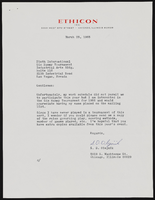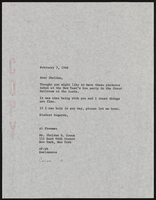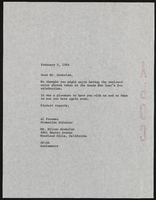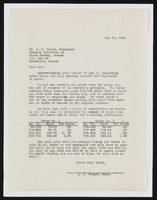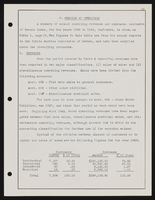Search the Special Collections and Archives Portal
Search Results
George Stewart Personal Papers
Identifier
MS-00828
Abstract
The George Stewart Personal Papers (1914-2014) are comprised of military records and personal papers of George Stewart, a fifty-year Las Vegas, Nevada resident. The collection includes information about the Clark County Republican Party, Stewart's service in the United States Army Air Corps, and documents and photographs from Stewart's childhood in the Boy Scouts of America during the 1930s and 1940s. The collection also contains a personal scrapbook containing photographs, fliers, and memorabilia from his early education and military training. Stewart also collected menus and keychains from local Las Vegas, Nevada country clubs and casinos.
Archival Collection
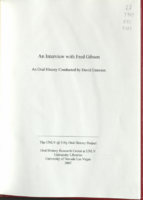
Transcript of interview with Fred Gibson by David Emerson, February 13, 2008
Date
2008-02-13
Archival Collection
Description
Fred Gibson's family came to Nevada in 1929; moving to Ely, Carson City, and eventually Las Vegas. He went into the Army after high school graduation and then studied Japanese at Yale. After some time in Colorado, Fred transferred to UNR and graduated from the Mackay School of Mines. Fred and his dad organized Pacific Engineering and Production Company of Nevada in 1955. The company merged with American Pacific in 1982 and today, among other enterprises, manufactures drugs at a facility in Rancho Cordova. His brother James Gibson served almost 30 years in the Nevada legislature. As a trustee director of the Nevada Development Authority (NDA), Fred was instrumental in organizing support for the idea of an engineering school at UNLV. Fred worked with people like Robert Maxson, Bob Gore, Jack McBride, Bill Flangas, and John Goolsby. He also teamed with Kenny Guinn to elicit donations from individuals and corporations, and lobbied the legislature to garner support for the school. As a member of the University Foundation, Fred has had a lot of interaction with Georgia Tech, and is trying to get the State of Nevada to approve a Georgia plan. He believes this will help the UNLV College of Engineering reach the level of schools like Georgia Tech and MIT. He also encourages the legislature to allow the university to use unclaimed property funds, but this idea still has not met with approval.
Text
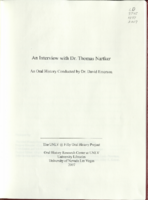
Transcript of interview with Dr. Thomas Nartker by Dr. David Emerson, November 13, 2006
Date
2006-11-13
Archival Collection
Description
Thomas Nartker was born and raised in Dayton, Ohio, and most of his family, including three brothers and a sister, still live there. He attended grade school and high school there, and then attended the University of Dayton. He majored in chemical engineering, following the example of his father, who had a degree in electrical engineering. By the time he was a sophomore in college, he was six-foot nine and had spent some time on the basketball court, but when asked to play his senior year at U. of D., he declined. He had already been accepted for graduate study at the University of Tennessee. Thomas finished all course work and research on his master's in one year, everything but the thesis. He interviewed over 30 companies before he graduated, but an interview with DuPont in Delaware made him think about the value of a PhD in his line of work. He applied and was accepted at Texas A&M. He worked with Dave Billingsley, who was the resident computer expert, and Dave showed him how to process all the data he had collected for his master's thesis on the IBM 650. Tom had found a new passion. Within a year, Tom was working as an assistant in the data processing center at Texas A&M, and was also the teaching assistant for the computer programming class. After completing his PhD, which took 6 years, Thomas began interviewing again. He accepted a position at New Mexico Institute of Mining and Technology (NMIMT) as assistant professor of mathematics and director of the computing center. He left NMIMT in 1981 and took a job with Shell Oil Company, which included 5 years as a visiting staff member at Los Alamos. In 1985 he met John Werth, who ultimately offered Tom a job at UNLV. Tom made the move to Las Vegas in July of 1985. Dr. Nartket and Dr. Taghva started the UNLV Information Science Research Institute and did experimental research on Optical Character Recognition (OCR) for the Department of Energy (DOE). They invented many metrics never seen before, including a metric called Nonstop Word Accuracy. Today UNLV is known worldwide for being the premier center for doing research in OCR technology. Thomas is in his seventies today and continues with his research and teaching because he loves it. He has enjoyed over two decades at UNLV and finds it a rewarding and intellectual place to be. He considers this university to be one of the most exciting in the country as it grows in research and service.
Text
Pagination
Refine my results
Content Type
Creator or Contributor
Subject
Archival Collection
Digital Project
Resource Type
Year
Material Type
Place
Language
Records Classification

